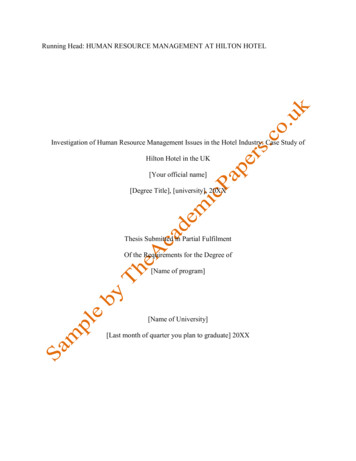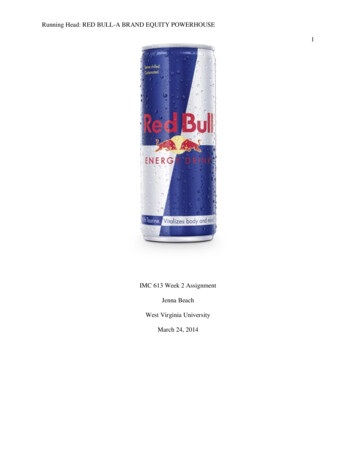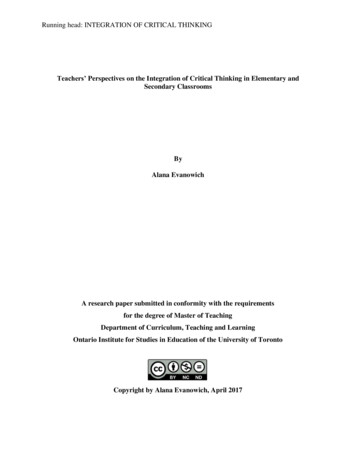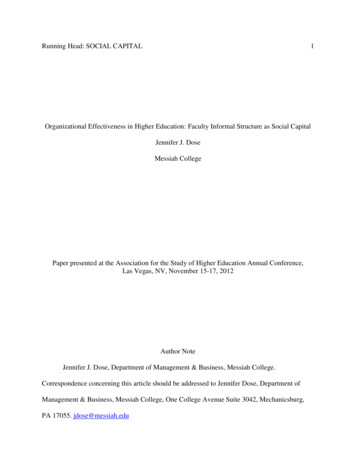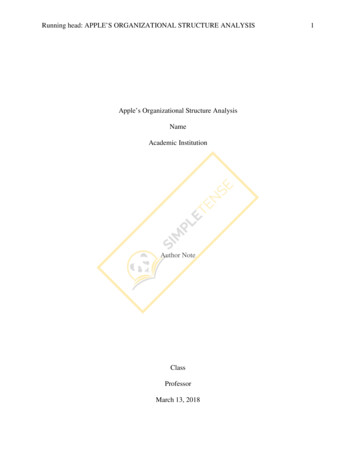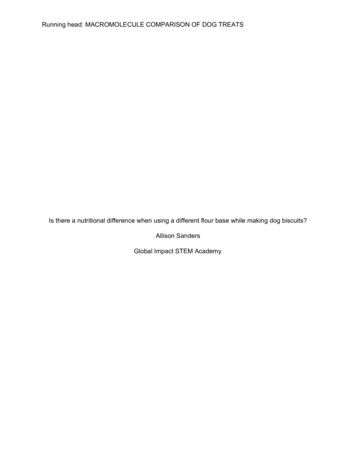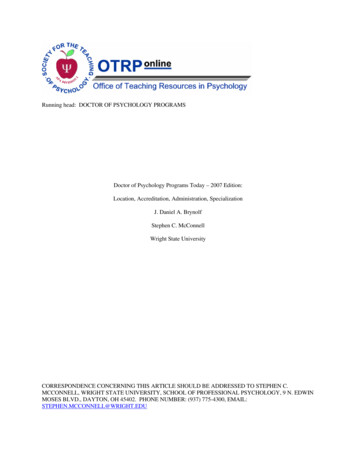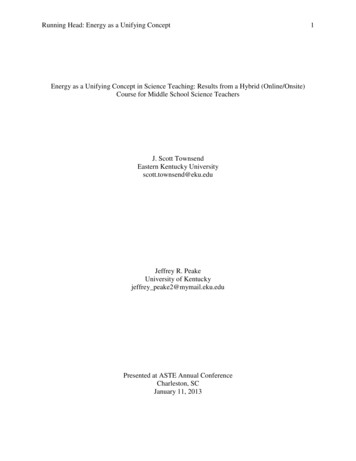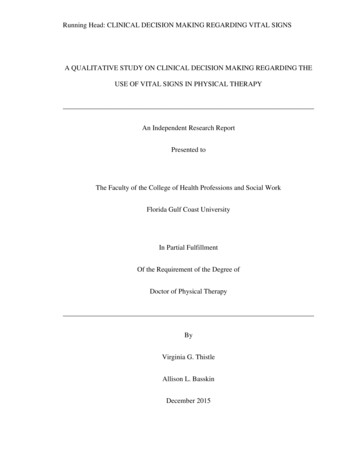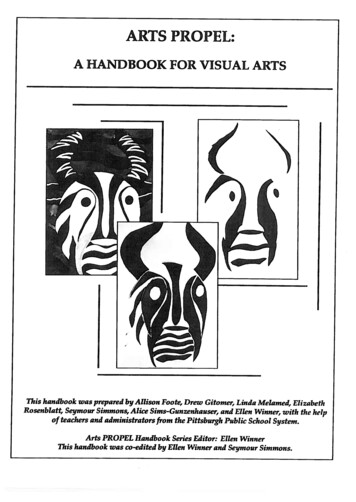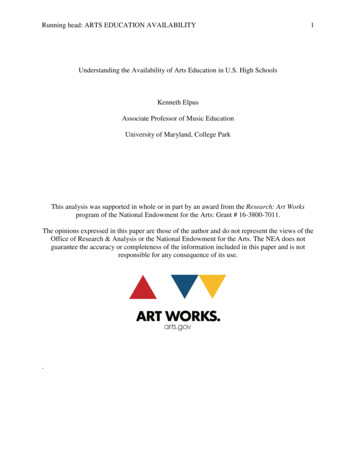
Transcription
Running head: ARTS EDUCATION AVAILABILITY1Understanding the Availability of Arts Education in U.S. High SchoolsKenneth ElpusAssociate Professor of Music EducationUniversity of Maryland, College ParkThis analysis was supported in whole or in part by an award from the Research: Art Worksprogram of the National Endowment for the Arts: Grant # 16-3800-7011.The opinions expressed in this paper are those of the author and do not represent the views of theOffice of Research & Analysis or the National Endowment for the Arts. The NEA does notguarantee the accuracy or completeness of the information included in this paper and is notresponsible for any consequence of its use.
ARTS EDUCATION AVAILABILITY2Table of ContentsExecutive Summary 4Introduction4Study Methodology5Key Findings 5Conclusions and Next Steps Error! Bookmark not defined.Full Paper8Introduction8Method11Data Source and Preparation for Analysis.11Empirical Approach. 13Results 14Availability of Arts Education in American High Schools. . 14Availability by Arts Discipline and Course. 15Arts Course Counts. 16School Control, School Type, and Arts Availability 17School Control.18Public School Type. 19School Characteristics Associated with Arts Course Offerings in Public Schools 21Bivariate AnalysesUrbanicity.2222Region of the County. 24Proportion of Students Receiving Free or Reduced Price Lunch.25
ARTS EDUCATION AVAILABILITY3Student Racial/Ethnic Composition. 27School Schedule.28School Size. 30Multivariate Analyses 32School characteristics and the offering of any arts. 32School characteristics and offering visual art.School characteristics and offering music.35School characteristics and offering theater. 36School characteristics and offering dance.Discussion373734
ARTS EDUCATION AVAILABILITY4Executive SummaryIntroductionCollectively, the arts education offered at the nation’s public schools represents thelargest investment by the American people in continuation of our aesthetic and artistic culture.The value and impact of schoolbased arts education reverberates through the entire nation’sartistic economy and community: Data from the National Endowment’s most recent Survey ofPublic Participation in the Arts confirms that formal, schoolbased arts education experiences inchildhood are strongly associated with later adult arts engagement as creator, performer, patron,or donor/financial supporter (Elpus, 2015). Thus, arts education in schools is truly an investmentin the artistic future of the nation.And yet, arts education, which has overwhelming popular support in public opinion polls(Americans for the Arts, 2005), is not universally available in the nation’s secondary schools.According to estimates from the National Center for Education Statistics (Parsad & Spiegelman,2012), in the 2009-2010 school year formal music instruction was available at 91% of publicsecondary schools and formal visual art instruction was available at 89% of secondary schools.The availability of theater and dance instruction lagged considerably behind that of music andvisual art: formal theater instruction was offered at 45% of American secondary schools; formaldance instruction was available at only 12% of secondary schools.The purpose of the present study was to understand what contextual factors are associatedwith the comprehensiveness of a high school’s arts offerings. We sought to go behind the “topline” numbers available in the Parsad & Spiegelman report by understanding what schoolcharacteristics were common to the schools that did—and did not—offer arts instruction in oneor more of the four major arts disciplines of visual art, dance, music, and theater.
ARTS EDUCATION AVAILABILITY5Study MethodologyWe used data from the National Center for Education Statistics (NCES) High SchoolLongitudinal Study of 2009 (HSLS) to analyze the relationships between school factors and artsavailability. Specifically, we examined the complete high school course catalogs available in theHSLS data to understand the availability of arts education at a nationally representative sampleof 940 high schools that participated in HSLS. We gathered school characteristic informationfrom the HSLS data, and where these were insufficient for any one school because of missingdata issues, we instead used the school characteristics as reported annually to the US Departmentof Education as part of the Common Core of Data (for public schools) and Private School Study(for private schools). Prior to conducting our main analyses, we manually verified the coursecatalog data to ensure that all arts courses appearing in the dataset were properly coded in termsof the arts discipline and subarea. Data were analyzed using appropriate survey-adjustedcategorical data analysis tools (Rao-Scott adjusted 𝜒𝜒2 and logistic regression) for both bivariateand multivariate analyses.Key Findings & Implications The strongest and most consistent school factor related to arts availability—including theoffering of any arts course and each of the arts disciplines considered individually—wasschool size. As the enrollment in a school increased, so too does the likelihood that theschool offers a more comprehensive arts program. We cannot determine a reason for thisassociation in the present study, though it seems reasonable to suspect that the economiesof scale achieved in schools with larger student populations seem to make it more likelythat schools could support staffing and facility space for arts programs. Although the
ARTS EDUCATION AVAILABILITY6reason is not yet clear, those interested in promoting access to arts education shouldremain engaged with the school size debate—those advocating advantages for schoolswith smaller enrollments should be encouraged to ensure that arts courses remainavailable if smaller-school reforms are undertaken. Traditional public high schools, by far, have the greatest likelihood of offering artseducation. Of all school types (public and private), public charter high schools had theleast availability of arts education. Within the private school sector, Catholic schools farsurpassed non-Catholic private schools in terms of arts availability. Charter schoolleaders should be pressed to increase the offering of arts education within their schools,as the lack of availability of comprehensive arts education seems to disadvantage charterschool students in terms of access to a quality arts education in comparison to theirtraditional public school peers. Those promoting expansion of the charter school sectorshould be encouraged to ensure that the arts are a viable part of the curricula at futurecharter schools, especially given the status of music and the arts as enumerated parts of a“well rounded curriculum” as defined by the Every Student Succeeds Act, the currentincarnation of federal public school law. Although prior research indicates there are arts education uptake variations by race andethnicity, we do not find that the availability of any particular arts course significantlyvaries with the racial/ethnic composition of the school, except for music, where there wasa slight relationship. However, no clear pattern of availability or lack of availabilityemerged, suggesting that future research within music specifically is warranted. The proportion of students eligible for free- or reduced price lunch is significantly relatedto the availability of the arts in America’s high schools; however, the relationship is
ARTS EDUCATION AVAILABILITY7different for public schools and private schools. In the public high schools, as theproportion of students eligible for free or reduced price lunch increases, the likelihood ofoffering arts education decreases. In the private schools, this trend is reversed, andgreater proportions of students eligible for free- or reduced-price lunch are associatedwith increased availability of the arts. This may be an artifact of the Catholic/nonCatholic private school divide where Catholic schools offer more arts classes than nonCatholic private schools. The Catholic high schools are more likely to serve greaterproportions of poorer students than are the non-Catholic private schools. However, moreresearch in this area is needed to clarify the root cause of this finding. Urbanicity (that is, a school’s location in an urban, rural, or suburban area) was notsignificantly associated with whether or not a school would offer any visual art or music.However, dance and theater, which are considerably less available than visual art andmusic, are exceptionally underrepresented among the offerings of rural schools. Region of the country was not significantly associated with the availability of artsoverall; however, descriptive results showed that different arts disciplines are moreprevalent in different regions. The visual arts had the greatest availability in the WesternUnited States, music had the greatest availability in the Midwest, while theater and dancehad the greatest availability in the South.
ARTS EDUCATION AVAILABILITY8Full PaperIntroductionCollectively, the arts education offered at the nation’s public schools represents thelargest investment by the American people in continuation of our aesthetic and artistic culture.The value and impact of school-based arts education reverberates through the entire nation’sartistic economy and community: Data from the National Endowment’s most recent Survey ofPublic Participation in the Arts confirms that formal, school-based arts education experiences inchildhood are strongly associated with later adult arts engagement as creator, performer, patron,or donor/financial supporter (Elpus, 2015). Thus, arts education in schools is truly an investmentin the artistic future of the nation.And yet, arts education, which has overwhelming popular support in public opinion polls(Americans for the Arts, 2005), is not universally available in the nation’s secondary schools.According to estimates from the National Center for Education Statistics (Parsad & Spiegelman,2012), in the 2009-2010 school year formal music instruction was available at 91% of publicsecondary schools and formal visual art instruction was available at 89% of secondary schools.The availability of theater and dance instruction lagged considerably behind that of music andvisual art: formal theater instruction was offered at 45% of American secondary schools; formaldance instruction was available at only 12% of secondary schools.Because of the overview nature of Parsad and Spiegelman’s (2012) report, they offerlittle speculation or concrete justification for the uneven access to comprehensive arts education,other than to note that the offering of various arts disciplines consistently “varied by [a school’s]concentration of poverty, measured by the percentage of students eligible for free orreducedprice lunch” (p. 14). Beyond the concentration of poverty among students served by a
ARTS EDUCATION AVAILABILITY9school, there is little to no rigorous national research exploring the factors that are associatedwith schools offering comprehensive arts education programs or little to no arts educationprograms.Though the data provided by Parsad and Spiegelman are useful, their report suffers oneadditional weakness when trying to understand how to support comprehensive arts education inschools: It was beyond the scope of their investigation to explore the comprehensiveness of theirresponding school’s arts programs. That is, each discipline was categorized simply as being“offered” or “not offered,” with no clear distinction made between schools that offered only onemusic or art course from those with sequential curricula in all four areas. From their work, then,it is impossible to understand from their report the full range of contextual factors whichcontribute to making a school’s offered curriculum truly “arts rich” or “arts poor” (Ruppert &Nelson, 2006; Thomas, Singh, Klopfenstein, & Henry, 2013). For example, there are manydocumented cases of schools with high concentrations of student poverty offering exceptionalarts education programs, such as the Turnaround Arts schools (Stoelinga, Silk, Reddy, &Rahman, 2015) and some of the A arts integration schools in North Carolina and elsewhere(Noblit, Corbett, Wilson, & McKinney, 2008). Other important contextual factors, such as stateeducational policies (e.g., arts graduation requirements), school size (in terms of enrollment),number of arts educators per capita, school urbanicity, and the average proportion of a school’sgraduating students going on to postsecondary education remain unexplored or explored only atthe state level in the literature.Longitudinal research of student outcomes has consistently suggested that when at-risk ornot at-risk students engage in arts education, they outperform their non-arts peers on a host ofeducational, social, and behavioral outcomes (Catterall, Dumais, & Hampden-Thompson, 2012),
ARTS EDUCATION AVAILABILITY10even when controlling for other demographics. Given that arts education is beneficial to at-riskand not at-risk youth, a clearer and more comprehensive picture of the status of arts education inthe nation’s high schools would, at the very least, help educational policymakers and artsphilanthropists understand where investments in arts education are working and where futureinvestments could be targeted for the greatest return. Yet this clear picture does not yet exist inthe research literature. The proposed study seeks to address this gap in the evidence.The purpose of this study was to develop a national profile of the availability of artseducation in American high schools and to understand what contextual factors are associatedwith the comprehensiveness of high school arts offerings. Data were drawn from the completecourse catalogs and school profiles of a nationally representative sample of schools included inthe third followup (2013 data collection) of the NCES High School Longitudinal Study of 2009(HSLS09). Specifically, the study will address the following descriptive and explanatoryresearch questions:(1) What is the proportion of high schools in the United States which offer curricularcoursework in: music, visual art, dance, and theater? What types of courses are most commonlyoffered within each discipline (e.g., music: band, choir, orchestra, AP Music theory; visual art:2D studio art, ceramics, sculpture; theater: acting, playwriting; dance: techniques, repertoire,choreography, etc.)?(2) In schools where any arts courses are offered, what is the average number of artscourses and arts disciplines offered?(3) How does the availability of arts education in American high schools vary by schoolcharacteristics and contextual factors? Specifically, how do arts offerings vary with: schoolcontrol and type, school urbanicity, region of the country, school socioeconomic profile
ARTS EDUCATION AVAILABILITY11(racial/ethnic composition, percent eligible for free/reduced lunch), school size (expressed interms of student enrollment), and school schedule type (e.g., block vs. traditional)?MethodData Source and Preparation for Analysis. Data for the present study were drawn fromtwo components of the High School Longitudinal Study of 2009 (HSLS), a large, nationallyrepresentative survey study of students and schools in the United States conducted by the U.S.Department of Education’s National Center for Education Statistics (NCES). HSLS is the mostrecent data collection effort in NCES’s ongoing series of national surveys on Americansecondary schools and students. HSLS traces a nationally representative cohort of Americanstudents (N 21,440) who were freshmen (i.e., ninth graders) in one of 940 public and privatehigh schools participating in the study during the 2009-2010 academic year. The sample forHSLS was complexly drawn in two stages: a series of randomly selected high schools fromacross the nation served as the primary sampling unit, and then students were randomly selectedfor participation from within the participating schools.In addition to surveying students, HSLS surveyed a school administrator (typically theprincipal), a school counselor, and two teachers who were currently working with the sampledstudents. For HSLS, school characteristics were collected from school administrators andcounselors as well as imputed from the Common Core of Data and the Private School UniverseSurvey, separate annual federal data collections of school information. Additionally, HSLScollected administrative data about the school’s course offerings (i.e., course catalogs) in a laterwave at the same time that sample members’ high school transcripts were collected. In thepresent study, we make use of school-level data only—demographic and other characteristics
ARTS EDUCATION AVAILABILITY12and the courses offered by the school—to generate a profile of the arts courses available in thenation’s public and private high schools. We use the appropriate school-level weight, as well asbalanced repeated replication (BRR) variance estimation, to ensure that all reported quantitiesare nationally representative and robust to the sampling procedures employed by HSLS.Course offering outcomes. As part of the student high school transcript data collectionin the 2013 update wave to HSLS, NCES collected complete high school course catalogs fromthe participating schools. Course data from all catalogs, including verbatim course titles, creditlevel, and other pertinent course information, was recorded in an HSLS course offering dataset.NCES then applied “School Courses for the Exchange of Data” (SCED) coding to each courseoffered. We identified arts courses offered at each school on the basis of the SCED codes appliedto the data.As arts courses are not a main focus element of HSLS, we manually verified the codingon all courses that had been coded as arts courses (N of courses 30,810) to ensure that theapplied code indicated the correct arts discipline and subarea based on the verbatim course title.We corrected errors for a limited number of course where, in our expert opinion, codes had beenmisapplied. This was necessary because some arts courses titles may appear misleading to thosewithout arts education expertise and are then consequently miscoded. For example, a coursetitled “Jazz Ensemble” would be immediately recognized by an arts education expert to refer toan instrumental ensemble despite the existence of, and codes for, vocal jazz ensembles. In thevery few cases (N 150) where the course titles remained ambiguous to us, we visited the schoolwebsite to examine course offering and catalog descriptions that were publicly available.Once course coding was verified, we determined which schools offered which coursesand generated a set of binary indicator variables for each arts discipline (visual art, dance,
ARTS EDUCATION AVAILABILITY13theater, and music) and for the key subareas within those disciplines. We use these binaryindicator variables as the source of our descriptive data and as the outcome variables in ourunivariate and multivariate analyses of characteristics associated with the offering of artscourses.Empirical Approach. Research Question (1). To answer Research Question (1), wecomputed the survey-weight-adjusted proportion of schools offering (1) any arts courses, (2)each of the four arts disciplines, and (3) each individual type of arts course—that is, the subareaswithin the arts disciplines. We computed the proportions separately for all high schools, forpublic high schools, for Catholic high schools, and for non-Catholic private high schools. Wereport the proportions as top-line percentages.Research Question (2). To answer Research Question (2), we computed survey-weightadjusted means for the number of courses and number of arts disciplines offered across all highschools in the nation. We report means, standard errors, and distributions.Research Question (3). We answer Research Question (3) in two steps. First, weestimate univariate associations between school characteristics and the offering of any artscourse and the offering of the specific arts disciplines. To compute these estimates forcategorical school characteristics (such as the urbanicity of the school), we use the Rao-Scottadjusted 𝝌𝝌2 (Rao & Scott, 1984), a survey adjusted test of the independence of two categoricalvariables, analogous to the Pearson 𝝌𝝌2 statistic used to analyze data arising from a simplerandom sample. A significant result on the Rao-Scott statistic indicates that the characteristic inquestion is associated with arts course availability. For continuous characteristics, such as the
ARTS EDUCATION AVAILABILITY14size of the school expressed in terms of student enrollment, we use a univariate survey-adjustedlogistic regression model.We further analyze the relative importance of each significant univariate characteristic byestimating multivariate survey-adjusted logistic regression models. In the multivariate models,we use as predictors any characteristic that was found to be associated with arts course offeringsin the univariate analyses. Our outcome measure for these models is the offering of (1) any artscourse, (2) any visual art course, (3) any dance course, (4) any theater course, and (5) any musiccourse. From the logistic regression models, we compute coefficients, odds ratios, and predictedprobabilities to understand the nature of the associations between school characteristics and thelikelihood of offering the various arts courses.ResultsAvailability of Arts Education in American High Schools. . We find that arts coursesare not universally available in American high schools. We estimate that 82% of all high schoolsin the nation offered at least one course in one or more of the four major arts disciplines: visualart, dance, theater, and music.Among all public high schools, 88% offered at least one arts course in any discipline.While 12% of public high schools offered no arts instruction, 12% offered only one of the fourarts disciplines, 28% offered two arts disciplines, 31% offered three arts disciplines, and 17%offered all four major arts disciplines. Not all public high schools in the United States areconsidered alike; public high schools are categorized into at least five major “types.” These typesare regular (or traditional) public high schools, public charter high schools, special program or
ARTS EDUCATION AVAILABILITY15magnet schools, vocational schools, and alternative schools. We find significant variation in theavailability of arts education at public high schools by public school type, F(3, 1090) 10.4, p .001. Fully 92% of traditional public high schools offered at least one arts course and 96% ofspecial program or magnet schools offered at least one arts course. Among alternative educationschools, 83% offered at least one arts course and 71% of vocational high schools offered at leastone arts course. Public charter schools, by far, have the lowest availability of arts courses: only37% of public charter high schools offered any arts instruction at all.In private high schools, there were fewer opportunities for students to study the arts. Only63% of all private high schools offered any arts instruction. While 37% of private schoolsoffered no arts courses, 1% offered only one of the four major arts disciplines, 28% offered twoarts disciplines, 26% offered three arts disciplines, and 8% offered all four major artsdisciplines. Similar to the public schools, there was variation in arts course offerings by the typeof private school. By far, Catholic schools make up the largest proportion of non-public highschools in the nation. Among Catholic high schools, 83% offered at least one arts course; this ismuch closer to the public school availability than the overall private school availability indicates.The bulk of the disparity between the public schools and private schools is driven by the lowerlevels of arts availability in the non-Catholic private schools. Arts courses were only available in57% of non-Catholic private high schools.Availability by Arts Discipline and Course. The four arts disciplines, and the subareasof courses within those disciplines, are not equally available in American high schools. Visual artwas the most available arts discipline; at least one course in visual art was offered in 79% of allhigh schools. Music was the second-most available arts discipline; at least one course in music
ARTS EDUCATION AVAILABILITY16was offered in 74% of all high schools. Courses in theater were available at 46% of highschools. The availability of dance lagged far behind the other arts disciplines; courses in dancewere offered in only 16% of schools.Among the four arts disciplines, availability varied by school characteristics. Tables 1through 4 display the availability of arts courses within discipline across school control and, forprivate schools, whether the school was a Catholic school or a non-Catholic private school.Course titles in Tables 1 through 4 are categories of courses from each discipline as grouped bySecondary Courses for the Exchange of Data (SCED) Coding, version 4.0. Generally speaking,non-charter public high schools offered the greatest opportunities for arts study, followed byCatholic schools and non-Catholic private schools. Public charter schools consistently offeredthe fewest opportunities for students to study the arts.Arts Course Counts. Across all schools, public and private, that offered at least one artsdiscipline, the average number of unique arts courses offered was 22.68 (SE 1.87). In publicschools with arts courses, the average number of unique courses offered was 24.81 (SE 2.25).In private schools (both Catholic and non-Catholic) with arts programs, the average number ofarts courses offered was smaller, 13.09 (SE 1.70). Focusing only on the Catholic schools, theaverage number of arts courses available at schools with arts programs was 17.36 (SE 1.45).Non-Catholic private schools with arts programs averaged 11.44 (SE 2.31) unique arts courses.Visual art. In public schools with visual art programs, the average number of uniquevisual arts courses offered was 9.98 (SE 0.82). In private schools (both Catholic and nonCatholic) with visual arts programs, the average number of courses available was 6.89 (SE 0.77). In the Catholic schools offering visual art, the mean number of unique courses was 8.39
ARTS EDUCATION AVAILABILITY17(SE 0.46). At non-Catholic private schools offering visual art, the average number of visual artcourses offered was 6.21 (SE 1.09).Music. In public schools with music programs, the average number of unique musiccourses offered was 12.55 (SE 1.34). In private schools with curricular music, the averagenumber of music courses offered was 4.76 (SE 0.66). Among Catholic schools with musicprograms, the average number of music courses offered was 6.28 (SE 0.77). In non-Catholicprivate schools offering any music, the average number of music courses offered was 4.21 (SE 0.87).Dance. In public schools with dance programs, the average number of unique dancecourses offered was 5.75 (SE 0.97). In private schools with dance programs, the averagenumber of dance courses offered was 3.06 (SE 0.68). At Catholic schools with danceprograms, the average number of unique courses in dance offered was 3.94 (SE 0.60). Amongnon-Catholic private schools offering dance courses, the average number offered was 2.16 (SE 1.38).Theater. In public schools with theater programs, the average number of unique theatercourses offered was 5.22 (SE 0.55). In private schools with theater programs, the averagenumber of theater courses offered was 2.87 (SE 0.65). In Catholic schools with theaterprograms, the average number of unique theater courses available was 3.66 (SE 0.40). Amongnon-Catholic private schools with theater programs, the average number of theater coursesoffered was 2.62 (SE 0.86).School Control, School Type, and Arts Availability
ARTS EDUCATION AVAILABILITY18School Control. In the descriptive results above, it is readily apparent that the publichigh schools tend to have greater availability of the various arts disciplines and courses than doprivate high schools as a whole. It is also clear that in most cases, the Catholic high schools havegreater availability of arts education than do private high schools which are not affiliated withthe Catholic church. Here, we apply statistical scrutiny to the availability of the arts by schoolcontrol using the Rao-Scott adjusted 𝝌𝝌2 (Rao & Scott, 1984) to determine whether thedifferences in availability by school control are statistically significant.Availability of any arts education. Table 5 summarizes the availability of any artscourse and any course within the four major arts disciplines by school control. The differences inavailability are statistically significant, F(2, 310) 13.08, p .001. Adjusted residuals indicatethat lower availability in non-Catholic private schools is the largest significant contributor to theoverall association between school control and arts availability.Availability of visual art education. As seen in Table 5, the differences betweenavailability of visual arts courses appears to vary by school control, with more public andCatholic high schools offering visual arts courses than non-Catholic private schools. Thedifference is statistically significant, F(2, 290) 14.24, p .001.Availability of music education. Similar to visual arts education, Table 5 showsdifferences in availability of music education by school control, with fewer non-Catholic privatehigh schools offering music courses than either public or Catholic high schools. The associationbetween school control and music offering is statistically significant, F(2, 290) 4.27, p .02.Availability of theater education. Theater courses are available at considerably fewerhigh schools than are courses in visual
2012), in the 2009-2010 school year formal music instruction was available at 91% of public secondary schools and formal visual art instruction was available at 89% of secondary schools. The availability of theate
